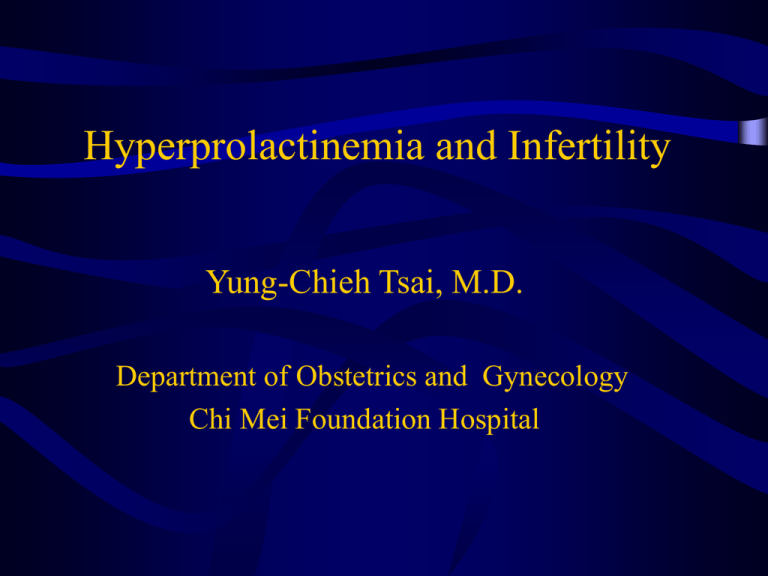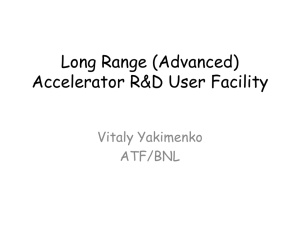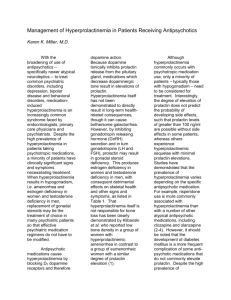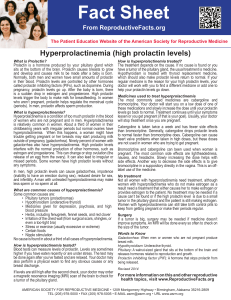Hyperprolactinemia and Infertility Yung-Chieh Tsai, M.D. Department of Obstetrics and Gynecology
advertisement

Hyperprolactinemia and Infertility Yung-Chieh Tsai, M.D. Department of Obstetrics and Gynecology Chi Mei Foundation Hospital Prolactin Molecular Structure A single polypeptide containing 199 amino acid residues with molecular weight 22000K.The structure is folded to form a globular shape, and the folds are connected by three disulfide bonds. Prolactin Member of somatomammotropin family Due to the remarkable homology of the amino acid sequence among the molecules of PRL, GH and PL (40%). It was not until 1970 that the prolactine molecule was identified. Prolactin Cell of Origin PRL is made by the pituitary lactotrophs. The number of lactotrophs are similar in number in both sexs and do not change significantly with age. Prolactin Synthesis and metabolism • Prolactine is secreted mainly by the lactotroph in the pituitary。 • Normal serum level= 10-25 ng/ml, half life =20 minutes • Metabolized in liver and kidney Prolactin Isoforms • Little PRL:80-90%, MW 23000K, nonglycosylated monomeric with high receptor binding bioactivity and full immuno-activity • Two glycosylated forms:G1 and G2 Prolactin Isoforms • Big PRL:8-20%, MW 50000K, mixture of dimeric and trimeric forms of G-PRL • Big-big PRL:1-5%, MW 100000K, polymeric, possibly representing G-PRL coupled covalently with immunoglobulin Prolactin Physiology ‧ ‧ ‧ ‧ ‧ ‧ ‧ Metabolic clearance and production rates Hormone secretion patterns Changes in PRL with age Changes in PRL during menstrual cycle Changes in PRL levels during pregnancy Changes in PRL with postpartum lactation Effects of thyroid hormone status on PRL Prolactin Function ‧ on the breast ‧ on gonadotropin secretion ‧ on the ovary ‧ on the testes ‧ on the adrenal cortex ‧ on the bones ‧ on carbohydrate metabolism ‧ on the kidney ‧ on the immune system Prolactin Receptors Identified receptors in PRL binds to its ‧ breast, liver, ovary, receptor with high ‧ kidney tubules affinity.Half-saturation ‧ adrenal cortex of the receptor occurs at ‧ prostate, testes, hormone concentration seminal vesicles, epididymis, of 7 ng/ml. ‧ brian, lung, ‧ lymphocyte, myocardium Hyperprolactinemia Pathologic conditions • Hypothalamic lesions Craniopharyngioma Glioma Granuloma Stalk transection Irradiation damage Pseudocysts • Pituitary tumors Cushing disease Acromegaly Prolactinoma • Reflex causes Chest wall injury herpes zoster neuritis Upper abdominal op • Hypothyroidism • Renal failure • Ectopic pdoduction Bronchogenic carcinoma Hypernephroma Hyperprolactinemia Pharmacologic conditions • Estrogen therapy • Anesthesia • DA receptor blocking agents Phenothiazones Haloperidol • Inhibition of DA turnover Opiates • DA re-uptake blocker Nomifensine • CNS-DA depleting agents Reserpine -methyldopa MAO inhibitor • Stimulation of serotoninergic system Amphetamines Hallucinogens • Histamine H2-receptor antagonists Hyperprolactinemia Physiologic conditions – Sleep – Feeding – Exercise – Coitus – Menstrual cycle – Amniotic fluid – Pregnancy – Puerperium – Nursing – Fetus – Neonate If a woman's prolactin level is elevated the first time it is tested, a second sample should be checked when she is fasting and non-stressed. Hyperprolactinemia Effects on Endocrine-Metabolic Functions • • • • • • • Increase lactogenesis Androgenic effects Liver:reduced SHBG Hyperinsulinemia and insuline resistance Decrease bone density Hypothalamic-pituitary dysfunction Impaired Ovarian Steroidogenesis Prolactin Neuroendocrine Regulation A. Dual hypothalamic regulation 1. PRFs: TRH, VIP, PHM 2. PIFs: dopamine is primary–possible role for GAP (GnRH-striated peptide) 3. PIF activity is dominant; PRL is under tonic inhibition by hypothalamus. If the stalk is cut, PRL levels rise whereas other hormone levels fall. Prolactin Neuroendocrine Regulation B. Primary target organ is the breast: suckling stimulates afferent pathways through cord to elicit PRL release in puerperium C. Metabolic factors: arginine and hypoglycemia stimulate D. Estrogen stimulates lactotrophs directly E. PRL is secreted episodically with nocturnal surge Hyperprolactinemia Clinical Manifestation A. Galactorrhea indicates elevated PRL in 10% of women and 99% of men B. Amenorrhea: indicates elevated PRL in 15% of women C. Galactorrhea plus amenorrhea: indicates elevated PRL in 75%of women D. Infertility: indicates elevated PRL in up to 33% of women E. Osteoporosis: increased with elevated PRL-due to estrogen lack. If normal menses are present, osteoporosis does notoccur. Hyperprolactinemia Diagnostic Evaluation • A. Basal PRL levels at least twice: 1. PRL >200 ng/mL = prolactinoma or renal failure 2. PRL <200 ng/ml = prolactinoma or any of the other causes • B. Routine history and physical, SMA 20 and TSH excludes almost all above except hypothalamic and pituitary disease • C. CT or MRI to differentiate hypothalamic/ pituitary disease from idiopathic, even with (anything > 25 mg/m!.) Hyperprolactinemia Mechanisms on Reproductive Dysfunction A. Inhibition of pulsatile GnRH secretion B. Interference with gonadotropin action in ovary C. Interference with estrogen positive feedback D. Inhibition of FSH-directed ovarian aromatase E. Inhibition of progesterone synthesis F. Impaired follicle development G. Inhibition of 5-alpha-reductase enzyme in men, thereby decreasing the conversion of testosterone to DHT Hyperprolactinemia Inhibition of pulsatile GnRH secretion Hyperprolactinemia inhibit GnRH activity by interacting with hypothalamic DA and opioidergic system via the short-loop feedback mechanism. Hyperprolactinemia Inhibition of pulsatile GnRH secretion Hyperprolactinemia Interference with gonadotropin action in ovary Animal study revealed prolactine can act as a potent inhibitor of LH-mediated androgen synthesis.Since androgen serve as substrates for estrogen production in the ovary, hypoestrogenism seen with hyperprolactinemic syndrome may be of ovarian origin.(Endocrinology 111:2001, 1982) Hyperprolactinemia Inhibition of FSH-directed ovarian aromatase High affinity prolactine receptors has been demonstrated on the surface of granulosa cells.These cells contain the aromatase enzyme.FSH induces aromatase enzyme activity in vitro and this effect is blocked by coincubation granulosa cells with high levels of prolactine(100 ng/ml).(Fertil Steril 38:182 1982) Hyperprolactinemia Inhibition of progesterone synthesis Prolactine is involved in the induction of LH receptors to maintain progesterone synthesis.Prolactine is necessary for complete lutenization.However, very high prolactin level in the early phase of follicular growth inhibit progesterone secretion.(J Endocrinol 64:555, 1975) Hyperprolactinemia Impaired follicle development • Samples of follicular fluid obtained from mature follicles contain lower PRL concentration approximating those found in serum,Highest PRL level occurs in the fluid of small follicle, reaching 5-6 fold greater than those in serum.If prolactin exceeds 100 ng/mL, 100% of the follicles are atretic.(Nature 250:653 1974) Hyperprolactinemia Treatment • A. Idiopathic hyperprolactinemia bromocriptine is effective in 85% • B. Microprolactinomas 1.Transsphenoidal surgery: initial cure rate 8085%, with a recurrence rate of 20%. Depends on skill of surgeon 2.Radiotherapy: ineffective and takes a long time 3.Bromocriptine: restores PRL to normal in 8085% Hyperprolactinemia Treatment 4.Observation only; follow PRL. Repeat CT/MRI if PRL levels rise • C. Macroprolactinomas 1. Surgery: cure rates <50% and very much dependent on size with recurrence rates 2050% 2. Bromocriptine: size reduction to <50% of original size in 50%, to 50% in 16% and to 10-30% in 33% Hyperprolactinemia Treatment a. First evidence of size reduction may occur after 6 weeks b. Size reduction does not correlate with basal or nadir PRL or percentage reduction in PRL levels c. In first 2-3 years, most will reexpand d. After a few years, few reexpand Hyperprolactinemia In Men • The role of serum prolactine in male infertility is still unclear.Normal PRL serum level have an essential permissive role in testicular and extratesticular physiology. PRL receptors are present on the membrane surfaces of testicular interstitial cells and PRL appear to promote the synthesis of testosterone by increasing the number of LH receptors in Leydig cells.. Hyperprolactinemia In Men • Hyperprolactinemia in men is manifested clinically by signs of androgen deficiency and infertility. It may be associated with impotence, loss of libido, and rarely gynecomastia and galactorrhea. Headaches and visual defects occur in patients with large pituitary adenomas. • While some men with apparent hyperprolactinemia are free of symptoms and compliants. Hyperprolactinemia Inhibition of 5-alpha-reductase enzyme Hyperprolactinemia in men with asthenozoospermia, oligozoospermia, or azoospermia.Arch Androl 1997 Group PRL<14(ng/ml) Total(121) 81(66.9%) Oligozoospermia(42) 30(71.4%) Asthenozoospermia(51) 30(58.8%) Azoospermia(28 21(75.0%) PRL>14(ng/ml) 40(33.1%) 12(28.6%) 21(41.2%) 7(25%) Hyperprolactinemia in men with asthenozoospermia, oligozoospermia, or azoospermia.Arch Androl 1997 Group PRL(ng/ml) T(ng/ml) E2(pg/ml) Normozoosp ermia(46) Oligozoosper mia(42) Asthenozoos permia(51) Azoospermia (28) 7.3(2.1) 4.9(1.5) 25.9(8.9) LH(mIU/ml) FSH(mIU/ml ) 4.7(3.6) 4.7(3.6) 12.6(7.8)* 5.1(1.5) 31.9(15.3) 4.8(3.1) 6.4(5.8) 13.9(6.6)* 5.2(1.4) 34.9(33.0) 4.1(3.3) 4.7(4.0) 10.9(4.8)* 4.5(1.8) 26.2(16.0) 10.3(8.6)* 12.1(9.1)* Hyperprolactinemia in men with asthenozoospermia, oligozoospermia, or azoospermia.Arch Androl 1997 • Patients with idiopathic oligoasthenozoospermia and hyperprolactinemia were treated with 2.5 mg of bromocriptine daily for 6 months, resulting in a nonmeasurable effect on their sperm analysis. • In conclusion, two-thirds of patients with oligozoospermia, asthenozoospermia, and azoospermia have normal PRL levels. Bromocriptine was of no therapeutic utility. Influence of serum prolactin on semen characteristics and sperm function. Int J Fertil 1991 • Serum samples of 204 males were examined during a 1-year period. • No significant correlation of sPRL concentration was found with results of semen analysis, PCT outcome. The functional sperm capacity was better in the groups of patients with sPRL above the median level (P less than .005). No significant difference in pregnancy rate was found between the high (greater than 5 ng/mL) and low (less than or equal to 5 ng/mL) prolactin groups; these were 20% and 26%, respectively Influence of serum prolactin on semen characteristics and sperm function. Int J Fertil 1991 • The results suggest that routine screening of asymptomatic male patients during infertility investigation for sPRL concentration is not helpful for assessing fertility prognosis. Prolactin should be preferentially determined in patients with clinical symptoms of hyperprolactinemia to exclude pituitary adenoma. Hyperprolactinemia Differential Diagnosis A.Medications: neuroleptics, metoclopramide, methyldopa, MAO inhibitors,tricyclic antidepressants, verapamil B.Pregnancy C.Hypothyroidism D.Renal insufficiency E.Cirrhosis F.Neurogenic: breast, chest wall, spinal cord lesions G.Hypothalamic disease: tumors, sarcoidosis, non-secreting pituitary tumors, neuraxis irradiation, stalk section H.Empty sella syndrome I. Acromegaly Hyperprolactinemia Special Considerations • A. Tumor fibrosis: primarily a problem for macroadenomas in that it may decrease later surgical cure rate. If tumor shrinks bromocriptine should be continued. • B. Long-term bromocriptine: taper and try to discontinue • C. Growth of tumor while on bromocriptine: noncompliance or possible carcinoma or hemorrhage into tumor Hyperprolactinemia Special Considerations • D. Options for patients still hyperprolactinemic after surgery who do not respond to bromocriptine 1.Other dopamine agonists: cabergoline (Dostinex) is well tolerated, once weekly dosing, pergolide (Permax), is once daily 2. Reoperation 3. Irradiation Hyperprolactinemia Special Considerations • E. Intolerance to bromocriptine 1. Try intravaginal bromocriptine: no nausea and vomiting 2. Try cabergoline • F. Concomitant estrogen use: safe for almost all patients. Must follow PRL levels to detect the rare patient that may have an estrogeninduced increase in tumor size Hyperprolactinemia in Polycystic Ovaries • PRL levels have been found to be elevated in 19-50% of women with polycystic ovaries(PCO). The precise link as to what is causing what is still not firmly established, but it may be the hyperestrogen levels that are occurring in PCO. • Bromocriptine treatment of hyperprolactinemia patients with PCO usually results in a reduction of testosterone and LH levels and resumption of ovulatory cycles. Pregnancy and Prolactinomas • A. No teratogenicity or other untoward effects on fetus of bromocriptine in >6,000 pregnancies • B. Risk of symptomatic microadenoma enlargement: 1.6% • C. Risk of symptomatic macroadenoma enlargement: 15.5% if no previous surgery/irradiation but only 4.3 % if previous surgery/irradiation. Pregnancy and Prolactinomas • Options: 1. Stop bromocriptine when pregnancy diagnosed and observe. If tumor enlarges, reinstitute bromocriptine----if fails, surgery. 2. Operate on tumor prepregnancy to allow room to enlarge 3. Continue bromocriptine throughout pregnancy





